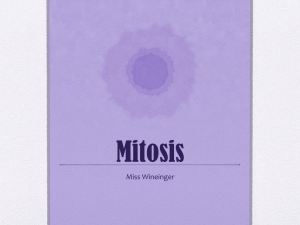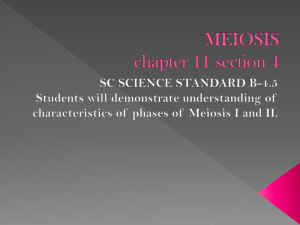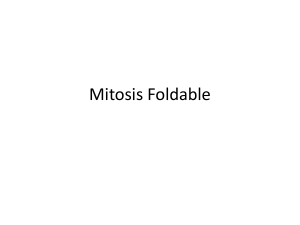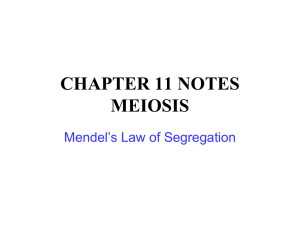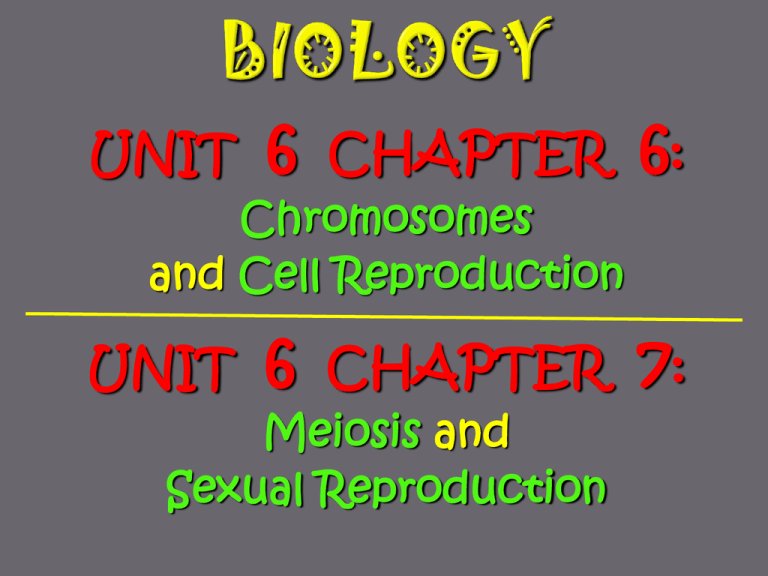
UNIT
6 CHAPTER 6:
Chromosomes
and Cell Reproduction
UNIT
6
CHAPTER
Meiosis and
Sexual Reproduction
7:
About 2 trillion cells are produced by
an adult human body every day – about
25 million new cells per second.
The type of cell division differs
depending on the organism.
A prokaryote cell such as bacteria
reproduces by binary fission.
Binary fission is a form of asexual
reproduction that occurs in bacteria and
produces two identical daughter cells of equal
size.
First, the DNA is copied, then the cell divides.
Eukaryote cells reproduce by mitotic
cell division.
Mitotic cell division, or mitosis, is
cell division that produces genetically
identical, or cloned, daughter cells.
Mitosis involves a series of steps that
results in the formation of two identical
nuclei.
Mitosis differs in plant cells and animal
cells.
There are two main differences
between cell division in plant cells
and animal cells.
In plant cells, a cell plate forms to
divide the two new cells.
A cell plate is a membrane-bound cell
wall that forms across the middle of the
plant cell to separate the plant cell into
two new cells.
Animal cells do not form a cell plate.
Instead, animal cells form a cleavage
furrow.
A cleavage furrow is an indentation
that pinches apart the two new cells.
The second difference is that plant cells
do not have centrioles, but they do form
a spindle that is almost identical to that
of an animal cell.
Gametes are an organism’s reproductive
cells, such as spore or egg cells.
A zygote is a fertilized egg cell, the first
cell of a new individual.
A gene is a segment of DNA that carries the
code for a protein or RNA molecule.
As a eukaryotic cell begins to divide, the
chromosomes – the DNA and the proteins
associated with the DNA – becomes visible.
A chromosome is
one of the structures
in the nucleus that are
made up of DNA and
protein.
Chromosomes
function to pass on
genetic information
from one generation to
the next.
Before cell division,
each chromosome is
duplicated, or copied.
This is known as DNA
replication.
Each replicated
chromosome
consists of two
identical “sister
chromatids, ”
which are
strands of a
chromosome
that become
visible during
mitosis or
meiosis.
Each pair of
chromatids is
attached at an
area near the
center called the
centromere.
half of a chromatid pair
Homologous chromosomes are
chromosomes that are similar in size,
shape, and genetic content.
Each homologue in a pair of homologous
chromosomes comes from one of the two
parents.
The 46 chromosomes in human somatic
cells (or body cells) are actually 23 pair of
chromosomes. One set comes from the
mother, and one set comes from the father.
Somatic cells, or body cells, are all of
the cells in the body other than gametes.
Diploid means a cell contains two sets
of chromosomes, usually one from the
mother and one from the father. The
diploid number is the total number of
chromosomes of the organism.
Human body cells are diploid.
The diploid number can be written as
2N = 46, where ‘N’ represents one set
of chromosomes.
Haploid means a cell contains
one set of chromosomes – or
half the total number for the
organism.
Human sex cells, or gametes,
are haploid.
The haploid number can be
written as N = 23.
SEX CHROMOSOMES
Autosomes are chromosomes that
are not directly involved in
determining the sex, or gender, of an
individual.
The sex chromosomes, one of the
23 pair of chromosomes in humans,
contain genes that will determine the
sex of the individual.
In human males, the sex chromosomes
are made up of one X chromosome and
one Y chromosome (XY).
The sex chromosomes in human females
consists of two X chromosomes (XX).
Because a female can donate only an X
chromosome to her offspring, the sex of
an offspring is determined by the
male, who can donate either an X or a Y
chromosome.
A karyotype is a photo of the
chromosomes in a dividing cell that shows
the chromosomes arranged by size.
Karyotypes describe the number of
chromosomes, and what they look like
under a light microscope.
Attention is paid to their length, the
position of the centromeres, banding
pattern, any differences between the sex
chromosomes, and any other physical
characteristics.
Karyotypes can be used to find
abnormalities in human chromosomes.
A person must have the characteristic
number of chromosomes in their cells for
normal development and function.
Trisomy is a condition that results in
abnormal development when humans have
more than two copies of a chromosome.
Down syndrome, or trisomy 21,
results when an individual has an extra
copy of chromosome 21.
What events can cause an individual to
have an extra copy of a chromosome?
When sperm and egg cells form, each
chromosome and its homologue pair
separate, an event called disjunction.
TRISOMY 21
If one or more chromosomes fail to
separate properly – an event occurs
called nondisjunction -- one new
gamete ends up receiving both
chromosomes and the other gamete
receives none.
Trisomy occurs when the gamete with
both chromosomes fuses with a normal
gamete during fertilization, resulting in
offspring with three copies of that
chromosome instead of two.
Older mothers are more likely to have a baby
with Down syndrome because all the eggs a
female will ever produce are present in her
ovaries when she is born, unlike males who
produce new sperm throughout adult life.
As a female ages, her eggs can accumulate an
increasing amount of damage.
Because of this risk, a pregnant woman over
the age of 35 may be advised to undergo
prenatal testing that includes fetal
karyotyping.
deletion mutation – a piece of
chromosome breaks off completely,
causing the new cell to lack a certain set
of genes after cell division
duplication mutation – a
chromosome fragment attaches to it
homologous chromosome, which will
then carry to copies of a certain set of
genes
inversion mutation – a chromosome
piece reattaches to the original
chromosome but in a reverse orientation
translocation mutation – occurs if a
piece of chromosome reattaches to a
nonhomologous chromosome
TYPES OF CELL DIVISION
Cell division, or cell
reproduction, is the
process through which a
cell divides to form two
new cells called daughter
cells.
There are three basic
types of cell division:
1.) asexual reproduction,
2.) mitosis, and
3.) meiosis.
TYPES OF CELL DIVISION
1.) The first type is
asexual reproduction,
cell division in prokaryotes
(bacteria).
2.) The second type is
mitosis, or cell division in
eukaryotes for the purpose
of growth and repair.
3.) The third type is
meiosis, or cell division
that produces gametes, or
sex cells.
A
S
E
X
U
A
L
Cell Division in Bacteria
Prokaryotes reproduce through binary fission.
Binary fission is a form of asexual reproduction that
occurs in bacteria (prokaryotes) and produces two identical
daughter cells of equal size.
First, the DNA is copied, then the cell divides.
The two daughter cells are identical to the original parent
cell from which they formed.
The cell life cycle has two major periods:
interphase and cell division.
Interphase is the longer phase where the
cell is actively growing and carrying on
metabolic activities.
Cell division consists of two events:
1.) mitosis -- division of the nucleus, and
2.) cytokinesis -- division of the cytoplasm.
A cell spends 90% of its time in the G1
cycle, or phase, of interphase.
How does a cell know when to divide?
In eukaryote cells, the cell cycle is
controlled by many proteins.
Feedback signals from these proteins
occur at key checkpoints (G1 and G2
checkpoints) during interphase, letting the
cell know if it is healthy and large enough
to divide.
Gap 1
Synthesis
Gap 2
Mitosis
G1
S
Cells grow, increase in size, and carry out routine
functions in Gap 1. The G1 checkpoint control
mechanism ensures that everything is ready for DNA
synthesis.
DNA replication occurs during this phase. At the end of
this phase, each chromosome consists of two
chromatids attached at the centromere.
G2
During the gap between DNA synthesis and mitosis, the
cell will continue to grow. The G2 checkpoint control
mechanism ensures that everything is ready to enter the
M (mitosis) phase and divide.
M
Cell growth stops at this stage and cellular energy is
focused on the orderly division into two daughter cells.
A checkpoint in the middle of mitosis (Metaphase
checkpoint) ensures that the cell is ready to complete
cell division.
Cancer is the uncontrolled growth of
cells caused by a mutated protein that
does not respond normally to the body’s
control mechanisms.
In cancer, cells divide and grow
uncontrollably, forming malignant tumors,
and invade nearby parts of the body.
The cancer may also spread to more
distant parts of the body through the
lymphatic system or bloodstream.
Not all tumors are cancerous.
Benign tumors do not grow uncontrollably, do not invade
neighboring tissues, and do not spread throughout the body.
Malignant tumors tend to become progressively worse and
to potentially result in death.
A malignant tumor contrasts with a non-cancerous benign
tumor in that a malignancy is not self-limited in its growth,
and is capable of invading into adjacent tissues, and may be
capable of spreading to distant tissues. A benign tumor has
none of those properties.
There are over 200 different known cancers that afflict
humans.
Chromosomes are replicated (copied) during the
Synthesis phase (S) of Interphase, and the
chromosome number doubles.
Chromosomes appear as threadlike coils called chromatin
at the beginning of interphase.
Each chromosome and its copy (called sister chromosomes)
change to sister chromatids at the end of this phase.
Nucleus
Cell
Membrane
Chromatin
What the cell looks like
Animal Cell
What’s occurring
39
Animal Cell
Plant Cell
There are 4 main stages of mitosis:
PROPHASE: occurs when the genetic material in the
cell, which is normally loosely bundled, condenses, or
thickens, to form chromosomes. Each chromosome has
duplicated and now consists of two sister chromatids.
METAPHASE: occurs when the chromosomes align
themselves along the cell spindle in the middle of the cell,
ready to separate
ANAPHASE: occurs when the sister chromatids
separate and move to opposite ends of the cell
TELOPHASE: occurs when the cell prepares to cleave,
or separate, into two parts
Animated Mitosis Cycle
MITOSIS ANIMATION LINK
http://www.cellsalive.com/cell_cycle.htm
MITOSIS VIDEO CYCLE
http://www.youtube.com/watch?v=NR0mdDJMHIQ&feature=related
http://www.youtube.com/watch?v=DD3IQknCEdc
http://www.youtube.com/watch?v=K6ZRlJsHu4o
During prophase, the
chromatin condenses,
forming the
chromosomes.
Pairs of sister
chromatids are joined at
the centromere.
The nuclear membrane
breaks down.
Centrioles appear and
begin to move to
opposite ends of the cell.
Spindle fibers form
between the poles.
The centromere is the part of a chromosome
that links sister chromatids.
During mitosis, spindle fibers attach to the
centromere
In animal cells, a pair of centrioles is found
inside each centrosome.
Centrioles and spindle fibers are both made of
hollow tubes of protein called microtubules.
Each spindle fiber is made of an individual
microtubule.
Each centriole is made of nine triplets of microtubules
in a circle.
Plant cells do not have centrioles, but they form a
spindle that is almost identical to that of an
animal cell.
Animal Cell
Centrioles
Plant Cell
Spindle fibers
Chromatids (or
pairs of
chromosomes) attach
to the spindle fibers.
The pairs of
chromosomes cluster
and line up on the
equator of the cell.
Each chromosomes
is attached to a
spindle fiber at its
centromere.
Animal Cell
Plant Cell
Chromatids separate and
begin to move to opposite
ends of the cell.
The centromeres that have
held the chromatids
together split, and the
chromatids become
chromosomes again.
Sister chromatids are
pulled apart by the spindle
fibers towards the
opposite poles.
Animal Cell
Plant Cell
Chromatids reach the
opposite poles.
The chromosomes uncoil to
become threadlike chromatin
again.
The spindle fibers break down
and disappear.
A nuclear envelope forms
around each chromatin mass,
and nucleoli appear in each
of the daughter nuclei.
Animal Cell
Cleavage furrow
Plant Cell
Cell plate
Cytokinesis
Cytokinesis is the division of the
cytoplasm and the organelles to form
two new daughter cells.
Cytokinesis usually begins during
late anaphase and completes during
telophase.
A cleavage furrow appears and
squeezes or pinches the original
cytoplasmic mass into two parts.
During cytokinesis in animal cells and
other cells that lack cell walls, the cell
is pinched in half by a belt of protein
threads.
In plant cells and other cells that have rigid cell
walls, the cytoplasm is divided in a different way.
In plant cells, vesicles formed by the Golgi
apparatus fuse at the midline and form a cell
plate.
A cell plate is a membrane-bound cell wall that
forms across the middle of a plant cell.
A new cell wall then forms on both sides of the
cell plate.
Animal Mitosis -- Review
1. Interphase
2. Prophase
3. Metaphase
4. Anaphase
5. Telophase
6. Interphase
Plant Mitosis -- Review
1. Interphase
2. Prophase
3. Metaphase
4. Anaphase
5. Telophase
6. Interphase
PROPHASE
METAPHASE
ANAPHASE
TELOPHASE
PROPHASE
METAPHASE
ANAPHASE
TELOPHASE
58
MITOSIS ANIMATION LINK
http://www.cellsalive.com/cell_cycle.htm
MITOSIS VIDEO CYCLE
http://www.youtube.com/watch?v=AhgRhXl7w_g
http://www.youtube.com/watch?v=ZEwddr9ho-4
(Baylor University dance on field)
http://www.youtube.com/watch?v=NVfqzSKa_Bg&
feature=related
http://www.dnatube.com/video/1322/mitosis
Section 3
Meiosis and Sexual Reproduction
Meiosis is a form of cell division that halves the
number of chromosomes when forming
specialized reproductive cells, such as gametes
or spores.
Meiosis involves two divisions of the
nucleus, which is called Meiosis I and
Meiosis II.
The DNA in the original cell is replicated
during the synthesis cycle (S) of interphase
BEFORE meiosis begins. So, meiosis starts
with homologous chromosomes.
Meiosis is the
production of sex
cells. One diploid
cell divides to form
four haploid
daughter cells.
The four haploid
daughter cells
produced by meiosis
will form into
gametes.
male = sperm
female = eggs
The phases of meiosis are the same as mitosis only the cell
goes through cell division twice – Meiosis I and Meiosis II.
Four haploid cells will be produced at the end of Telophase
II, each having half the number of chromosomes as the
original parent cell.
Meiosis I
Meiosis II
Prophase II
Metaphase II
Anaphase II
Telophase II
Chromosomes do not
replicate between
Meiosis I and Meiosis II.
A new spindle forms
around the
chromosomes.
The chromosomes
line up in a similar
way to the
metaphase stage
of mitosis.
The sister
Meiosis II results
chromatids
in four haploid (N)
separate and move daughter cells.
toward opposite
ends of the cell.
Prophase I:
Chromosomes
condense, and
the nuclear
envelope breaks
down.
tetrad
Each chromosome pairs with its corresponding
homologous chromosome to form a tetrad.
A tetrad contains 4 chromatids (or two
chromosomes).
Chromatids formed during Prophase I
exchange portions of their chromatids in
a process called crossing over.
Crossing over is a process that occurs
during Prophase I when portions of a
chromatid on one homologous
chromosome are broken and exchanged
with the corresponding chromatid
portions of the other homologous
chromosome.
Crossing-over produces new allele
combinations and is a key source of genetic
variation (species diversity) in multicellular
organisms.
An allele is one of the alternative forms of a gene
that governs a characteristic, such as hair color.
tetrad
allele
chromatid
The random distribution of
homologous chromosomes
during meiosis is called
independent assortment.
About 8 million gametes
with different genes
combinations can be
produced from one original
cell.
Each of the 23 pair of
chromosomes separates
independently.
Metaphase I:
The pairs of homologous chromosomes are
moved by the spindle to the equator (middle of
the cell) and remain together.
Anaphase I:
The homologous chromosomes separate
during Anaphase I and are pulled toward the
poles of the cell by the spindle fibers.
The chromatids do not separate at their
centromeres during Anaphase I. Each
chromosome is still composed of two
chromatids. However, the genetic material
has recombined.
Telophase I:
Individual chromosomes gather at each of the poles.
In most organisms, the cytoplasm divides
(cytokinesis), forming two new cells.
Both cells or poles contain one chromosome from
each pair of homologous chromosomes.
The two diploid cells produced by Meiosis I now
enter a second meiotic division (Meiosis II) which
results in the production of four haploid cells
that are genetically different.
The cell now enters Prophase II. No DNA
replication takes place – the chromosomes
already replicated during Interphase I.
Meiosis II: The Second
Division of the Nucleus
Prophase II:
A new spindle forms around the
chromosomes.
Metaphase II:
The chromosomes line up along the
equator and are attached at their
centromeres to spindle fibers.
Anaphase II:
The centromeres divide, and the chromatids
move to opposite poles of the cell. The
chromatids are now called chromosomes
because they are separated.
Telophase II:
A nuclear envelope forms around each set of
chromosomes. The spindle breaks down,
and the cell undergoes cytokinesis.
The result is four haploid cells.
Meiosis I
Meiosis II
Prophase II
Metaphase II
Anaphase II
Chromosomes do not
replicate between
Meiosis I and Meiosis II.
A new spindle forms
around the
chromosomes.
The
chromosomes line
up in a similar
way to the
metaphase stage
of mitosis.
The sister
chromatids
separate and move
toward opposite
ends of the cell.
Telophase II
A new nuclear envelope
forms around each set of
chromosomes.
Cytokinesis occurs.
Meiosis II results in four
haploid (N) daughter
cells.
Differences Found In Cell Division
Spermatogenesis is the
process by which sperm are
produced in male animals.
Four new cells from meiosis
called spermatids in males
develop into mature sperm cells.
Oogenesis is the process by which gametes
are produced in female animals.
During cytokinesis following meiosis in
females, the cytoplasm is divided unequally
among the four new cells.
One cell receives most of the original cell’s
cytoplasm and develops into a mature egg
called an ovum. The other three cells, called
polar bodies, die off.
When the nuclei of the
two gametes combine
during fertilization, the
2N number is restored
(2N = 46).
The fusion of two
gametes produces the
first cell of the new
animal called a zygote.
This diploid zygote cell
begins to divide by
mitosis and gives rise to
all the cells of the adult.
There are two types of twins. Fraternal twins
are produced when two eggs are released and two
separate sperm fertilize them. These twins are not
identical, although they may still look alike
because they are siblings.
Identical twins are produced when one egg is
fertilized by one sperm. During the zygote stage,
the egg splits into two. This creates two separate
embryos and thus the children will be identical
copies of each other --the same exact
chromosome match.
MITOSIS
MEIOSIS
>occurs in body cells
>occurs in sex cells
>one cell divides to
produce two new cells
>one cell divides to
produce four new cells
>involves one division
of the nucleus
>involves two divisions
of the nucleus
>end cells are diploid
>end cells are haploid
Sexual reproduction, with the formation of haploid
cells, occurs in eukaryotic organisms, including
humans.
In sexual reproduction, two parents each form
reproductive cells that have one-half the number of
chromosomes.
A diploid mother and a diploid father would give
rise to haploid gametes which join to form diploid
offspring.
Because both parents contribute genetic material, the
offspring have traits of both parents, but are not exactly
like either parent.
In asexual reproduction, a single parent
passes copies of all of its genes to each of its
offspring.
There is no fusion of haploid cells such
as gametes.
An individual produced by asexual
reproduction is a clone, an organism that is
genetically identical to its parent.
There are many different types of asexual reproduction.
Binary fission is the separation of parent into two or
more individuals of about equal size. Amoebas, a type
of protist, reproduce by binary fission.
Fragmentation is a type of asexual reproduction in
which the body breaks into several pieces. Planaria, a
type of flatworm, reproduce by fragmentation.
Budding is a type of asexual reproduction in which new
individuals split off from existing ones. Hydra reproduce
by budding.
A
S
E
X
U
A
L
Asexual reproduction is the simplest and
most primitive method of reproduction.
Asexual reproduction allows organisms
to produce many offspring in a short
period of time, without using energy to
produce gametes or to find a mate.
The DNA of these organisms varies little
between individuals.
This may be a disadvantage in a
changing environment because a
population of organisms may not be able
to adapt to a new environment.
In contrast, sexual reproduction
provides a powerful means of quickly
making different combinations of genes
among individuals.
Sexual reproduction creates
genetic diversity.
Plants, algae, and some protists have a life cycle that
regularly alternates between a haploid phase and a diploid
phase.
A sporophyte is the diploid phase in the life cycle of
plants that produce spores.
A spore is a haploid reproductive cell produced by
meiosis that is capable of developing into an adult without
fusing with another cell.
A gametophyte is the haploid phase in plants that
produces gametes by mitosis.
The sporophyte and the gametophyte generations alternate
in the life cycle of these plants.
Red moss spore
capsules
young sporophytes
of moss
That’s All
Folks!






